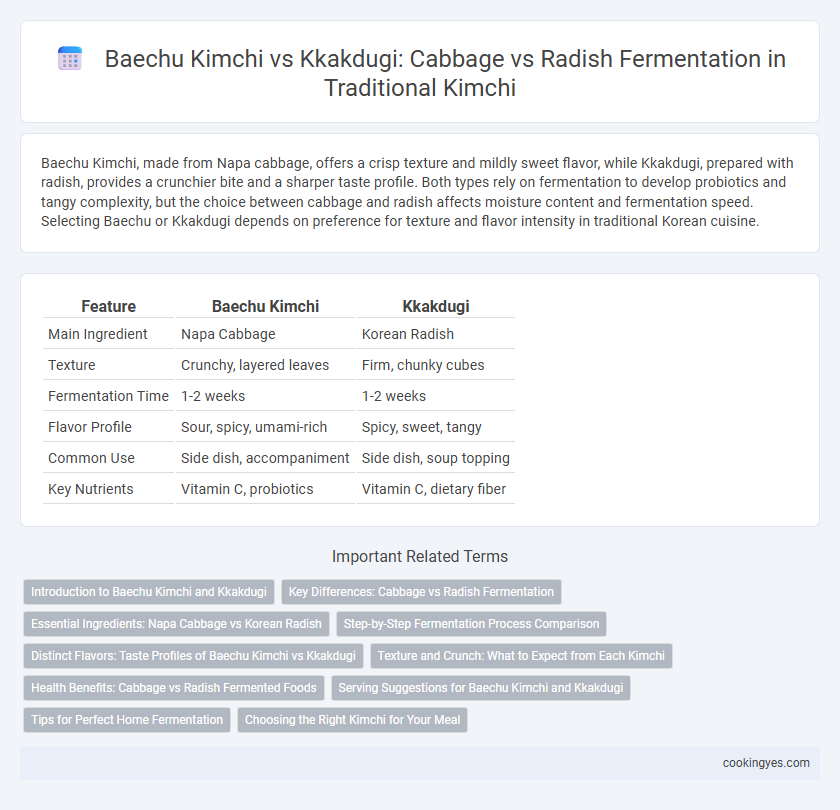Baechu Kimchi, made from Napa cabbage, offers a crisp texture and mildly sweet flavor, while Kkakdugi, prepared with radish, provides a crunchier bite and a sharper taste profile. Both types rely on fermentation to develop probiotics and tangy complexity, but the choice between cabbage and radish affects moisture content and fermentation speed. Selecting Baechu or Kkakdugi depends on preference for texture and flavor intensity in traditional Korean cuisine.
Table of Comparison
| Feature | Baechu Kimchi | Kkakdugi |
|---|---|---|
| Main Ingredient | Napa Cabbage | Korean Radish |
| Texture | Crunchy, layered leaves | Firm, chunky cubes |
| Fermentation Time | 1-2 weeks | 1-2 weeks |
| Flavor Profile | Sour, spicy, umami-rich | Spicy, sweet, tangy |
| Common Use | Side dish, accompaniment | Side dish, soup topping |
| Key Nutrients | Vitamin C, probiotics | Vitamin C, dietary fiber |
Introduction to Baechu Kimchi and Kkakdugi
Baechu Kimchi, made from napa cabbage, involves layering salted cabbage leaves with a spicy mixture of chili pepper, garlic, ginger, and fish sauce for fermentation, resulting in a tangy, crunchy texture. Kkakdugi uses cubed Korean radish, which ferments with similar seasonings but produces a firmer, juicier bite and a slightly sweeter taste. Both variations are staple Korean fermented dishes that emphasize different vegetable textures and flavor profiles while delivering probiotic benefits.
Key Differences: Cabbage vs Radish Fermentation
Baechu Kimchi ferments napa cabbage, resulting in a layered texture with a mild, slightly sweet flavor due to the cabbage's water content and leaf structure. Kkakdugi uses cubed Korean radish, producing a crunchier, denser texture with a sharper, more pungent taste from the radish's fibrous firmness and higher starch content. The fermentation process for cabbage involves quicker moisture release and softer fermentation, while radish fermentation develops a crisp bite and retains a more robust, spicy profile.
Essential Ingredients: Napa Cabbage vs Korean Radish
Baechu Kimchi primarily uses Napa cabbage, which provides a tender yet crunchy texture that absorbs the spicy, garlicky, and fermented flavors deeply during the fermentation process. In contrast, Kkakdugi relies on Korean radish, known for its firm, crisp bite and slightly sweet, earthy taste that balances the saltiness and heat in the fermentation. Both essential ingredients are rich in water content and natural sugars, creating optimal environments for lactic acid bacteria to thrive and develop distinct fermentation profiles.
Step-by-Step Fermentation Process Comparison
Baechu Kimchi fermentation begins with salting whole Napa cabbage to draw out moisture, followed by rinsing and applying a spicy paste, then allowing it to ferment at controlled cool temperatures for 1 to 2 weeks. Kkakdugi uses diced Korean radish, which is salted briefly, drained, mixed with chili flakes, garlic, and ginger, then fermented in airtight containers typically for 7 to 10 days. Both processes rely on lactic acid bacteria fermentation, but Baechu Kimchi requires more moisture control and longer initial brining compared to the shorter, more straightforward salting phase of Kkakdugi.
Distinct Flavors: Taste Profiles of Baechu Kimchi vs Kkakdugi
Baechu Kimchi features large napa cabbage leaves that ferment into a complex balance of tangy, spicy, and umami flavors with a crisp yet tender texture. Kkakdugi, made from cubed Korean radish, offers a crunchier bite with a sharper, slightly sweet, and refreshing taste due to the radish's natural water content and starches. The flavor profile of Baechu Kimchi is deeper and more layered, while Kkakdugi provides a clean, invigorating contrast ideal for complementing richer dishes.
Texture and Crunch: What to Expect from Each Kimchi
Baechu Kimchi, made from napa cabbage, offers a tender yet crisp texture as the leaves soften during fermentation while retaining a satisfying crunch in the ribs. Kkakdugi, crafted from cubed Korean radish, provides a more robust and firm crunch due to the denser, water-rich nature of radish cellulose. The fermentation process enhances the natural juiciness of both, but Baechu Kimchi typically delivers a layered, chewy bite, whereas Kkakdugi presents a consistently crisp and refreshing mouthfeel.
Health Benefits: Cabbage vs Radish Fermented Foods
Baechu Kimchi, made from fermented Napa cabbage, offers high levels of dietary fiber, vitamins C and K, and beneficial probiotics that support digestive health and boost the immune system. Kkakdugi, a fermented radish dish, provides rich amounts of antioxidants, vitamin A, and enzymes that aid in detoxification and improve metabolic functions. Both cabbage- and radish-based ferments promote gut microbiota diversity, but Baechu Kimchi tends to have greater antioxidant capacity, while Kkakdugi is valued for its digestive enzyme content.
Serving Suggestions for Baechu Kimchi and Kkakdugi
Baechu Kimchi, made from fermented napa cabbage, pairs excellently with Korean BBQ, rice dishes, and stews, enhancing savory flavors with its tangy crunch. Kkakdugi, a radish kimchi with a crisp texture and refreshing bite, is commonly served alongside hearty soups like seolleongtang and galbitang to balance richness. Both provide essential probiotics and a spicy-umami profile that complements traditional Korean meals.
Tips for Perfect Home Fermentation
Baechu Kimchi, made from Napa cabbage, requires salting the leaves thoroughly to draw out excess moisture and create an ideal texture for fermentation. Kkakdugi, a radish kimchi, benefits from cutting radish into uniform cubes and salting them to achieve crispness while balancing moisture levels during fermentation. Maintaining consistent temperature around 4-8degC and using sea salt instead of iodized salt enhances microbial activity for both Baechu and Kkakdugi, resulting in rich, tangy flavors.
Choosing the Right Kimchi for Your Meal
Baechu kimchi, made from napa cabbage, offers a crunchy texture and balanced fermentation ideal for complementing grilled meats and rice dishes. Kkakdugi, made from Korean radish, delivers a firmer bite and a sharper, tangier flavor perfect for hearty stews and spicy soups. Selecting between baechu kimchi and kkakdugi depends on the desired texture and flavor profile to enhance your meal experience.
Baechu Kimchi vs Kkakdugi for cabbage vs radish fermentation Infographic

 cookingyes.com
cookingyes.com